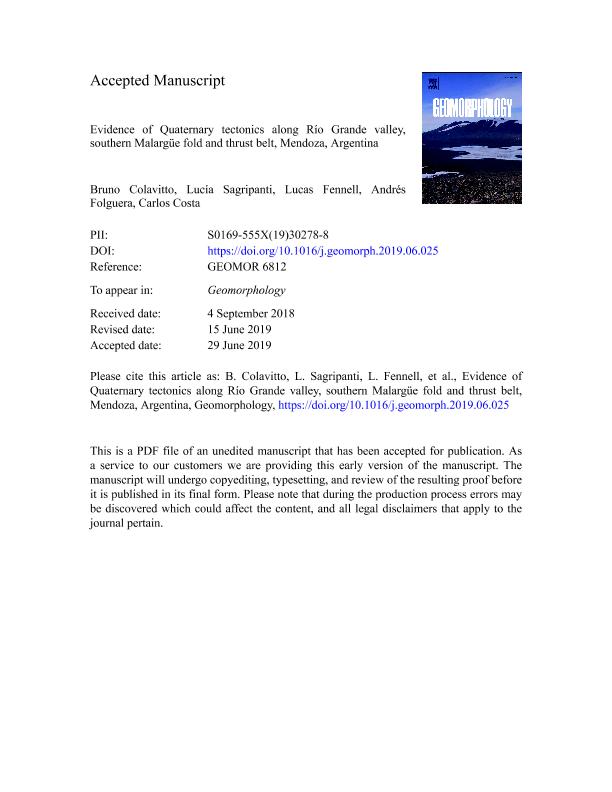Mostrar el registro sencillo del ítem
dc.contributor.author
Colavitto, Bruno

dc.contributor.author
Sagripanti, Lucía

dc.contributor.author
Fennell, Lucas Martín

dc.contributor.author
Folguera Telichevsky, Andres

dc.contributor.author
Costa, Carlos
dc.date.available
2020-02-13T20:44:40Z
dc.date.issued
2019-12
dc.identifier.citation
Colavitto, Bruno; Sagripanti, Lucía; Fennell, Lucas Martín; Folguera Telichevsky, Andres; Costa, Carlos; Evidence of Quaternary tectonics along Río Grande valley, southern Malargüe fold and thrust belt, Mendoza, Argentina; Elsevier Science Inc; Geomorphology; 346; 12-2019; 1-59
dc.identifier.issn
0169-555X
dc.identifier.uri
http://hdl.handle.net/11336/97494
dc.description.abstract
The Malargüe fold and thrust belt is developed in the Argentinian Andes between 34° and 37° S, through the tectonic inversion of Upper Triassic and Lower Jurassic depocenters of the Neuquén Basin, with an uplift history since the Cretaceous. Evidence of Quaternary deformation has been described in the northern part of it (34–34.5°S), potentially coeval to neotectonic activity along the eastern edge of San Rafael block. To the south, compressional and extensional structures active during the Quaternary were found in the Dorso de los Chihuidos along the Agrio fold and thrust belt front (37.5–38°S). Contrastingly, the southern segment of the Malargüe fold and thrust belt between these two areas with described neotectonic activity is partially covered by Quaternary products of the Payún Matrú volcanic field, that may hide evidence of recent deformation. In this 300 km gap of neotectonic information, the landscape imprint of two individual structures aligned in the mountain front through the Río Grande valley was analyzed. New evidence of neotectonic deformation were recognized, in particular over the western slope of the Cara Cura range, expressed by faulting and folding of Quaternary deposits and lava flows. An 40Ar/39Ar age from a deformed lava flow at the flanks of an anticline in the foothills of the Cara Cura range may suggest at least an upper Pleistocene compressional tectonic activity. Longitudinal river profile analysis revealed anomalies that show some correlation with the neotectonic structures described, especially knickpoints and concavity index changes. Meanwhile normalized steepness index values showed a moderate response to recent deformation. A proposed schematic geomorphic evolution for this segment of Río Grande river is discussed to put the neotectonic activity into the context of landscape formation. All together this evidence supports the idea of an active front through the Río Grande valley during the Quaternary, coetaneous to an active broken foreland to the east in the southern Central Andes.
dc.format
application/pdf
dc.language.iso
eng
dc.publisher
Elsevier Science Inc

dc.rights
info:eu-repo/semantics/openAccess
dc.rights.uri
https://creativecommons.org/licenses/by-nc-sa/2.5/ar/
dc.subject
MORPHOMETRY
dc.subject
NEOTECTONICS
dc.subject
PAYENIA
dc.subject
SOUTHERN ANDES
dc.subject.classification
Geología

dc.subject.classification
Ciencias de la Tierra y relacionadas con el Medio Ambiente

dc.subject.classification
CIENCIAS NATURALES Y EXACTAS

dc.title
Evidence of Quaternary tectonics along Río Grande valley, southern Malargüe fold and thrust belt, Mendoza, Argentina
dc.type
info:eu-repo/semantics/article
dc.type
info:ar-repo/semantics/artículo
dc.type
info:eu-repo/semantics/publishedVersion
dc.date.updated
2020-01-06T17:00:00Z
dc.journal.volume
346
dc.journal.pagination
1-59
dc.journal.pais
Países Bajos

dc.journal.ciudad
Amsterdam
dc.description.fil
Fil: Colavitto, Bruno. Consejo Nacional de Investigaciones Científicas y Técnicas. Oficina de Coordinación Administrativa Ciudad Universitaria. Instituto de Estudios Andinos "Don Pablo Groeber". Universidad de Buenos Aires. Facultad de Ciencias Exactas y Naturales. Instituto de Estudios Andinos "Don Pablo Groeber"; Argentina
dc.description.fil
Fil: Sagripanti, Lucía. Consejo Nacional de Investigaciones Científicas y Técnicas. Oficina de Coordinación Administrativa Ciudad Universitaria. Instituto de Estudios Andinos "Don Pablo Groeber". Universidad de Buenos Aires. Facultad de Ciencias Exactas y Naturales. Instituto de Estudios Andinos "Don Pablo Groeber"; Argentina
dc.description.fil
Fil: Fennell, Lucas Martín. Consejo Nacional de Investigaciones Científicas y Técnicas. Oficina de Coordinación Administrativa Ciudad Universitaria. Instituto de Estudios Andinos "Don Pablo Groeber". Universidad de Buenos Aires. Facultad de Ciencias Exactas y Naturales. Instituto de Estudios Andinos "Don Pablo Groeber"; Argentina
dc.description.fil
Fil: Folguera Telichevsky, Andres. Consejo Nacional de Investigaciones Científicas y Técnicas. Oficina de Coordinación Administrativa Ciudad Universitaria. Instituto de Estudios Andinos "Don Pablo Groeber". Universidad de Buenos Aires. Facultad de Ciencias Exactas y Naturales. Instituto de Estudios Andinos "Don Pablo Groeber"; Argentina
dc.description.fil
Fil: Costa, Carlos. Universidad Nacional de San Luis. Facultad de Ciencias Físico Matemáticas y Naturales. Departamento de Geología; Argentina
dc.journal.title
Geomorphology

dc.relation.alternativeid
info:eu-repo/semantics/altIdentifier/doi/http://dx.doi.org/10.1016/j.geomorph.2019.06.025
dc.relation.alternativeid
info:eu-repo/semantics/altIdentifier/url/https://www.sciencedirect.com/science/article/pii/S0169555X19302788
Archivos asociados
